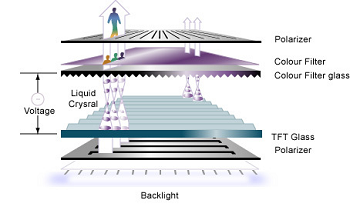Classification of LCD Panels
An LCD is composed of two pieces of glasses with a thin layer of liquid crystals in between. When a voltage is applied to the glasses, orientation of liquid crystals will be changed. This change in the crystal’s orientation (called polarization) will make either a dark or a light area, creating a character or image on the display.

Liquid crystal was discovered over 100 years ago, but it did not find any commercial application until the invention of twisted nematic (TN) LCD by Schadt and Helfrich in 1971.
TN
TN panels are characterized as being the fastest and cheapest among the other main types of display panels. However, TN panel offers narrower viewing angle. Because of its low response time and high refresh rate, gaming LCD monitor uses color TN panel quite a lot. And you usually see black & white TN LCD in small consumer electronics, like electronic watch and calculator.
HTN
As normal TN crystal twists 90 degrees, HTN (High Twisted Namatic) twists 110 to 130 degrees. Hence it increases contrast and view angles. HTN finds its application in multiplex LCD. HTN LCD price is a little bit higher than TN LCD, and its performance is a bit better than TN one.
STN
Though Twisted Nematic LCDs may be driven in a time multiplexed fashion to increase the amount of information displayed, they are restricted in terms of reduced contrast and limited viewing angle. To achieve more highly multiplexed displays, super twist technology is employed.
In this type of display, Liquid Crystal undergoes a greater than 90° twist from plate to plate; typical values range from 180 to 270 degrees. Polarizers in this case are not laid parallel to the Liquid Crystal at the surface but rather at some angle. Therefore the cell, does not work on a light "guiding" principle, as in Twisted Nematic LCDs, instead on a birefringence principle. The position of the polarizers, the cell thickness, and the birefringence of the LC are carefully chosen to result in a particular color in the "off" state. Usually, this is a yellow-green to maximize the contrast ratio. LC in the cell is "super twisted" that will give it the ability to use a high multiplex rate. As the twist is increased, the LC molecules in the middle of the layer are aligned with the applied electric field by smaller changes in voltage. This gives rise to a very steep transmission vs voltage curve, allowing up to 240-line multiplexing.
Because of its high multiplexing, STN LCD is good for words and graphic display. It normally comes with yellow-green or blue background.
FSTN
FSTN(Film compensated STN) panel has retardation film to STN display, which compensates for the colored background. This creates black & white screen, and provides higher contrast and wider viewing angle.
TFT
TFT (Thin-Film-Transistor) LCD employs a transistor for each pixel. By setting the level of electric field across the three capacitors (sub-pixel of red, green and blue) for a pixel, it controls the polarization of liquid crystal molecules. The amount of polarization determines the amount of light that reaches color filter from backlight. Thus, pixel's on/off and color can be actively controlled. TFT LCD is also called active-matrix LCD.
VA
VA (Vertical Alignment) panels are something of a compromise between TN and IPS. They offer the best contrast ratios, but have slower response time.
